The Program
An Academic Guitar Program
FRETBOARD BIOLOGY is a self-paced, highly organized system of learning that will help you master the theoretical and practical aspects of guitar so you can play at an advanced level. This program is designed to cover roughly eight semesters’ worth of required “main instrument” courses at an academic music program at institutions like Berklee School of Music, McNally Smith College of Music, or Musicians Institute, while providing the flexibility and low price point of self-directed learning. You will learn what you would learn in one of the top college guitar programs without the expense or inconvenience. FRETBOARD BIOLOGY gives you “The Knowledge without the College!” ™

Giving You What You Need
Video Lectures

FRETBOARD BIOLOGY includes over 500 video lectures in a specially-designed curriculum to help you develop your potential. Joe Elliott, the creator of the program, has a rare talent for explaining complex concepts in an understandable way, which will help you learn more quickly and easily.
Private Instruction
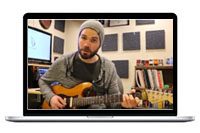
Want to make the most of the program? FRETBOARD BIOLOGY offers optional private instruction with highly experienced, professional instructors. Each instructor has many years of experience teaching individual students, as well as teaching the FRETBOARD BIOLOGYcurriculum at the college level.
Interactive Exercises and Quizzes
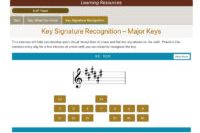
Each Unit in the FRETBOARD BIOLOGY includes includes exercises and quizzes that are designed to help you learn and internalize the most important information.
Text Books
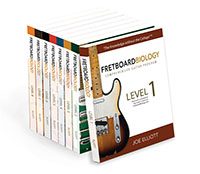
To help facilitate your learning, the FRETBOARD BIOLOGY program offers optional companion textbooks for the entire program. There are almost 2,000 pages of full-color text, examples, and exercises, in eight books. These are optional and can be purchased through most book retailers, including Amazon.com.
GET STARTED TODAY!
If you are serious about improving your guitar playing, there is simply no other program like FRETBOARD BIOLOGY. This is the only program that combines all the benefits of a structured professional guitar program with the low cost and convenience of self-learning.
LEVEL 1
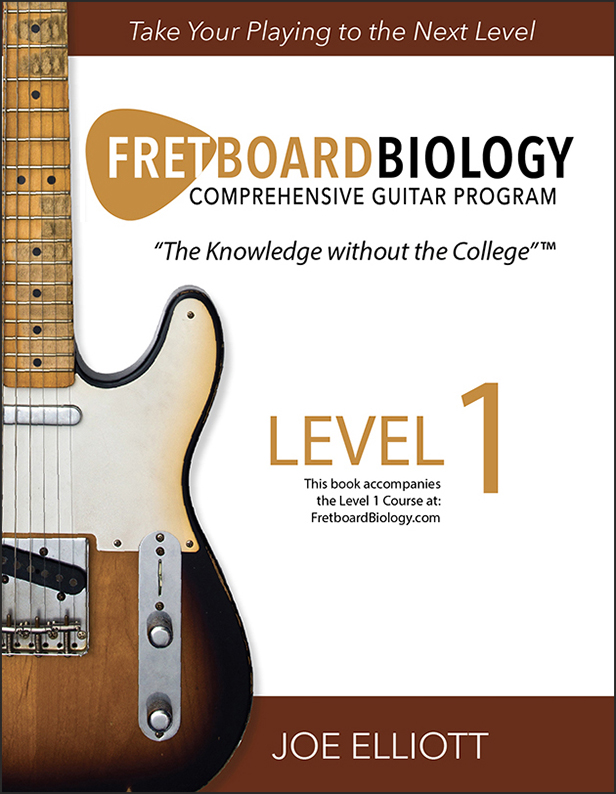
Unit 1
- THEORY: The staff, the musical alphabet, clef signs, intervals
- FRETBOARD LOGIC: Introduction to the Octave Shape System, notes of the fretboard, position
- TECHNIQUE: Fretting hand (finger numbers, finger orientation, thumb position, pressure), picking hand, alternate picking, using a metronome
- IMPROVISATION: Key center soloing, solo shaping and story telling, the five elements of contrast
- PRACTICE: How to build a practice routine
Unit 2
- THEORY: Natural notes, sharps and flats, naturally-occurring half staps, enharmonics, the major scale formula, the major pentatonic scale
- FRETBOARD LOGIC: The Pattern III major pentatonic scale, chord tones of Pattern IV barre chords, notes of the fretboard
- TECHNIQUE: Introduction to articulation techniques
- IMPROVISATION: Key center solo in a major key, motif development
- PRACTICE: Common questions about practicing
Unit 3
- THEORY: The natural minor scale formula, the minor pentatonic scale
- FRETBOARD LOGIC: Pattern IV minor pentatonic scale, chord tones of the Pattern II barre chords
- TECHNIQUE: Hammer-ons and pull-offs
- IMPROVISATION: Key center solo in a minor key, motif development
- PRACTICE: Unit 3 practice routine
Unit 4
- THEORY: Constructing the major scale, building major scales in keys using sharps
- FRETBOARD LOGIC: Pattern I major pentatonic scale, moving efficiently between barre chords
- TECHNIQUE: Half-step slides
- IMPROVISATION: Key center solo in a major key, motif development
- PRACTICE: Unit 4 practice routine
Unit 5
- THEORY: Sharp key signatures, diatonic notes, accidentals, chromatic scales
- FRETBOARD LOGIC: Pattern II minor pentatonic scale, efficient movement between barre chords
- TECHNIQUE: Bends and release bends
- IMPROVISATION: Key center solo in a minor key, motif development
- PRACTICE: Unit 5 practice routine
Unit 6
- THEORY: Flat key signatures
- FRETBOARD LOGIC: The Pattern III major scale, major open string chord voicings and chord tones
- RHYTHM GUITAR: Introduction to the rhythm guitar sequence
- IMPROVISATION: Key center solo in a major key, motif development
- PRACTICE: Unit 6 practice routine
Unit 7
- THEORY: Wrap-up for sharp and flat key signatures
- FRETBOARD LOGIC: The Pattern IV natural minor scale, efficient movement between open chords
- RHYTHM GUITAR: Comping in the blues
- IMPROVISATION: Key center solo in a minor key, motif development
- PRACTICE: Unit 7 practice routine
Unit 8
- THEORY: Parallel and relative keys
- FRETBOARD LOGIC: The Pattern I major scale, minor open string chord voicings and chord tones
- RHYTHM GUITAR: Comping in the blues
- IMPROVISATION: Key center solo in a minor key, motif development
- PRACTICE: Unit 8 practice routine
Unit 9
- THEORY: Natural minor sharp key signatures
- FRETBOARD LOGIC: The Pattern II natural minor scale, open chord voicing progressions
- RHYTHM GUITAR: Comping in the blues
- IMPROVISATION: Key center solo in a longer form major key progression using motif development, five elements of contrast
- PRACTICE: Unit 9 practice routine
Unit 10
- THEORY: Natural minor flat key signatures
- FRETBOARD LOGIC: Sus open string chord voicings
- RHYTHM GUITAR: Comping in the blues
- IMPROVISATION: Key center solo in a longer form major key progression using motif development and the five elements of contrast
- PRACTICE: Unit 10 practice routine
LEVEL 2

Unit 1
- THEORY: Identifying intervals
- FRETBOARD LOGIC: The Pattern II major pentatonic scale, pattern II major scale, mixing barre chords and open chord voicings, interval shapes on the fretboard—2nds and 3rds on one string, Introduction to the Octave Shape Family Tree
- TECHNIQUE: Alternate picking with 8th notes across strings
- RHYTHM NOTATION: Meter, measures, barlines, notes, and rests
- RHYTHM GUITAR: Folk rhythm guitar
- IMPROVISATION: Soloing with Straight 8th-note subdivision
- PRACTICE: Unit 1 practice routine
Unit 2
- THEORY: Measuring and Constructing Intervals
- FRETBOARD LOGIC: The Pattern IV major pentatonic scale, pattern IV major scale, mixing barre chords and open chord voicings, intervals on the fretboard—2nds and 3rds on adjacent strings
- TECHNIQUE: Alternate picking with a syncopated 8th-note subdivision
- RHYTHM NOTATION: Note heads, stems, and flags
- RHYTHM GUITAR: Folk rhythm guitar
- IMPROVISATION: Soloing with syncopated straight 8th notes
- PRACTICE: Unit 2 practice routine
Unit 3
- THEORY: Major, minor, augmented, and diminished triad formulas, sus4 chord formula
- FRETBOARD LOGIC: Pattern V major pentatonic scale, pattern V major scale, 3-string-set major triad shapes, intervals on the fretboard—4ths and 5ths on adjacent strings
- TECHNIQUE: Alternate picking with 16th note subdivision
- RHYTHM NOTATION: Meter and time signatures
- RHYTHM GUITAR: Folk rhythm guitar, fingerpicking
- IMPROVISATION: Soloing with a straight-16th note subdivision
- PRACTICE: Unit 3 practice routine
Unit 4
- THEORY: Analyzing triads, chord symbols
- FRETBOARD LOGIC: Pattern I minor pentatonic scale, pattern I natural minor scale, Triad Super Shapes, intervals on the fretboard—6ths on adjacent strings
- TECHNIQUE: Alternate picking with syncopated 16th-note subdivision
- RHYTHM NOTATION: Note and rest values
- RHYTHM GUITAR: Folk rhythm guitar, alternating bass fingerpicking
- IMPROVISATION: Soloing with a syncopated 16-note subdivision
- PRACTICE: Unit 4 practice routine
Unit 5
- THEORY: Triad construction
- FRETBOARD LOGIC: Pattern III minor pentatonic scale, Pattern III natural minor scale, creating parts with 3-string-set triad shapes, intervals on the fretboard—6ths and 7ths on non-adjacent strings
- TECHNIQUE: Alternate picking with 8th-note triplets
- RHYTHM NOTATION: Dots and ties
- RHYTHM GUITAR: Folk rhythm guitar progressions
- IMPROVISATION: Soloing with 8th-note triplets
- PRACTICE: Unit 5 practice routine
Unit 6
- THEORY: Harmonized major scale with triads
- FRETBOARD LOGIC: The Pattern V minor pentatonic scale, pattern V natural minor scale, patterns I and III major triad arpeggios, creating parts with 3-string-set minor Super Shapes, intervals on the fretboard—2nds and 3rds on adjacent top three strings
- TECHNIQUE: Alternate picking with syncopated 8th-note triplets
- RHYTHM NOTATION: Spacing and grouping of notes
- RHYTHM GUITAR: Classic rock rhythm guitar, common power chords
- IMPROVISATION: Soloing with syncopated 8th-note triplets
- PRACTICE: Unit 6 practice routine
Unit 7
- THEORY: Chord families, analyzing chord progressions in major keys
- FRETBOARD LOGIC: Overlapping pentatonic shapes, patterns II and IV minor triad arpeggios, voice leading, intervals on the fretboard—4ths and 5ths on adjacent top three strings
- TECHNIQUE: Alternate picking with 16th note triplets
- RHYTHM NOTATION: Note grouping with 8th notes
- RHYTHM GUITAR: Classic rock, open-A power chord vocabulary
- IMPROVISATION: Soloing with 16th-note triplets
- PRACTICE: Unit 7 practice routine
Unit 8
- THEORY: Harmonizing the minor scale, analyzing chord progressions in minor keys
- FRETBOARD LOGIC: Overlapping major and minor scale shapes, patterns II, IV, and V major triad arpeggios, intervals on the fretboard—6ths on non-adjacent top four strings
- TECHNIQUE: Alternate picking with syncopated 16th-note triplets
- RHYTHM NOTATION: Note grouping with 16th-note measures
- RHYTHM GUITAR: Classic rock, 1st inversion power chords
- IMPROVISATION: Soloing with 8th-note shuffle groove
- PRACTICE: Unit 8 practice routine
Unit 9
- THEORY: Constructing the blues scale
- FRETBOARD LOGIC: Patterns II and IV blues scale, pattern I, III, and V minor triad arpeggios, practical major triad shapes within the octave shape system, intervals on the fretboard—7ths on non-adjacent top four strings
- TECHNIQUE: Alternate picking with various articulation devices
- RHYTHM NOTATION: Common meters other than 4/4 time
- RHYTHM GUITAR: Comping in classic rock using Pattern III triad shapes
- IMPROVISATION: Soloing with chord tones
- PRACTICE: Unit 9 practice routine
Unit 10
- THEORY: Level 2 summary
- FRETBOARD LOGIC: Patterns I, III, and V blue scales, suspended fourth arpeggios, practical minor triad shapes within the octave shape system, intervals on the fretboard—octaves on all non-adjacent strings
- TECHNIQUE: Notating pick direction
- RHYTHM NOTATION: Clarity in notation
- RHYTHM GUITAR: Classic rock, triad shapes on String Set 2-3-4
- IMPROVISATION: Soloing with chord tones
- PRACTICE: Unit 10 practice routine
LEVEL 3
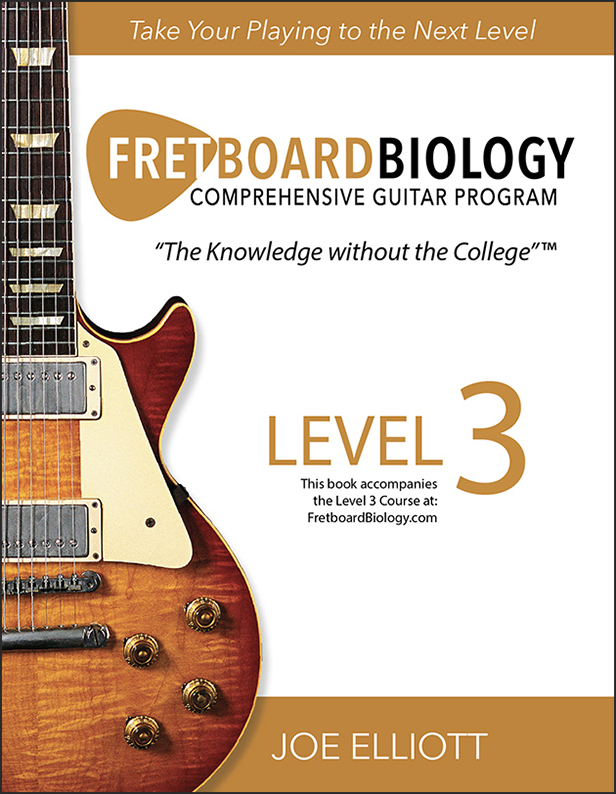
Unit 1
- THEORY: 7th chord formulas
- FRETBOARD LOGIC: Patterns I and III major 7th arpeggios, open string 7th chord voicings
- TECHNIQUE: Interval sequences in diatonic scales
- RHYTHM GUITAR: Comping in classic reggae
- MONEY MAKERS: Classic Pattern III major pentatonic Money Maker vocabulary
- IMPROVISATION: Soloing over a progression using 7th chord tones,
- PRACTICE: Unit 1 practice routine
Unit 2
- THEORY: Harmonizing the major scale with 7th chords
- FRETBOARD LOGIC: Patterns I and III dominant 7th arpeggios, chord progressions using open string 7th chord voicings
- TECHNIQUE: Interval sequences in diatonic scales
- RHYTHM GUITAR: Comping in classic reggae
- MONEY MAKERS: Classic Pattern III major pentatonic Money Maker vocabulary
- IMPROVISATION: Soloing using dominant 7 chord tones
- PRACTICE: Unit 2 practice routine
Unit 3
- THEORY: Harmonic analysis in a major key with 7th chords
- FRETBOARD LOGIC: Patterns II and IV minor 7th arpeggios, movable patterns II and IV major 7th chords
- TECHNIQUE: Interval sequences in diatonic scales
- RHYTHM GUITAR: Comping in classic reggae
- MONEY MAKERS: Classic Pattern III major pentatonic Money Maker vocabulary
- IMPROVISATION: Soloing using minor 7 chord tones
- PRACTICE: Unit 3 practice routine
Unit 4
- THEORY: Harmonic analysis in a major key with 7th chords
- FRETBOARD LOGIC: Patterns II and IV minor 7(b5) arpeggios, Patterns II and IV movable dominant 7th chords
- TECHNIQUE: Interval sequences in diatonic scales
- RHYTHM GUITAR: Comping in classic reggae
- MONEY MAKERS: Classic Pattern III major pentatonic Money Maker vocabulary
- IMPROVISATION: Soloing with minor 7(b5) chord tones
- PRACTICE: Unit 4 practice routine
Unit 5
- THEORY: Harmonic analysis in a major key with 7th chords
- FRETBOARD LOGIC: Patterns II, IV, and V major 7th arpeggios, patterns II and IV moveable minor 7th chords
- TECHNIQUE: Interval sequences in diatonic scales – 3rds
- RHYTHM GUITAR: Comping in classic reggae
- MONEY MAKERS: Classic Pattern III major pentatonic Money Maker vocabulary
- IMPROVISATION: Soloing with chord tones with major 7 and minor 7 chords
- PRACTICE: Unit 5 practice routine
Unit 6
- THEORY: Harmonized natural minor scale with 7th chords
- FRETBOARD LOGIC: Patterns II, IV, and V dominant 7th arpeggios, reading moveable 7th chord progressions
- TECHNIQUE: Interval sequences in diatonic scales – 4ths
- RHYTHM GUITAR: Comping in country
- MONEY MAKERS: Minor pentatonic Money Maker vocabulary for blues
- IMPROVISATION: Soloing with 7th chord tones with minor 7 and dominant 7 chords
- PRACTICE: Unit 6 practice routine
Unit 7
- THEORY: Harmonic analysis with 7th chords in minor keys
- FRETBOARD LOGIC: Patterns I, II, and V minor 7th arpeggios, reading moveable 7th chord progressions
- TECHNIQUE: Interval sequences in diatonic scales – 5ths
- RHYTHM GUITAR: Comping in country
- MONEY MAKERS: Minor pentatonic Money Maker vocabulary for blues
- IMPROVISATION: Soloing with chord tones with major 7 and dominant 7 chords
- PRACTICE: Unit 7 practice routine
Unit 8
- THEORY: Blues harmony
- FRETBOARD LOGIC: Patterns I, II, and V minor 7(b5) arpeggios, reading moveable 7th chord progressions
- TECHNIQUE: Interval sequences in diatonic scales – 6ths
- RHYTHM GUITAR: Comping in country
- MONEY MAKERS: Minor pentatonic Money Maker vocabulary for blues
- IMPROVISATION: Soloing with chord tones with minor 7, minor 7(b5), and dominant 7 chords
- PRACTICE: Unit 8 practice routine
Unit 9
- THEORY: Blues harmony and melody
- FRETBOARD LOGIC: Organize harmonized major scale arpeggios “in position” in all five octave shapes, all practical 7th chord shapes within the Octave Shape System
- TECHNIQUE: Interval sequences in diatonic scales – 7ths
- RHYTHM GUITAR: Comping in country
- MONEY MAKERS: Minor pentatonic Money Maker vocabulary for blues
- IMPROVISATION: Soloing with chord tones—the in-position approach
- PRACTICE: Unit 9 practice routine
Unit 10
- THEORY: Level 3 summary: 7th chords, harmonized major and natural minor scales with 7th chords, blues harmony, harmonic analysis
- FRETBOARD LOGIC: Organize harmonized minor scale arpeggios “in position” in all five octave shapes, all practical 7th chord shapes within the octave shape system
- TECHNIQUE: Level summary
- RHYTHM GUITAR: Comping in country
- MONEY MAKERS: Minor pentatonic Money Maker vocabulary for blues
- IMPROVISATION: Soloing with chord tones—the in-position approach
- PRACTICE: Unit 10 practice routine
LEVEL 4
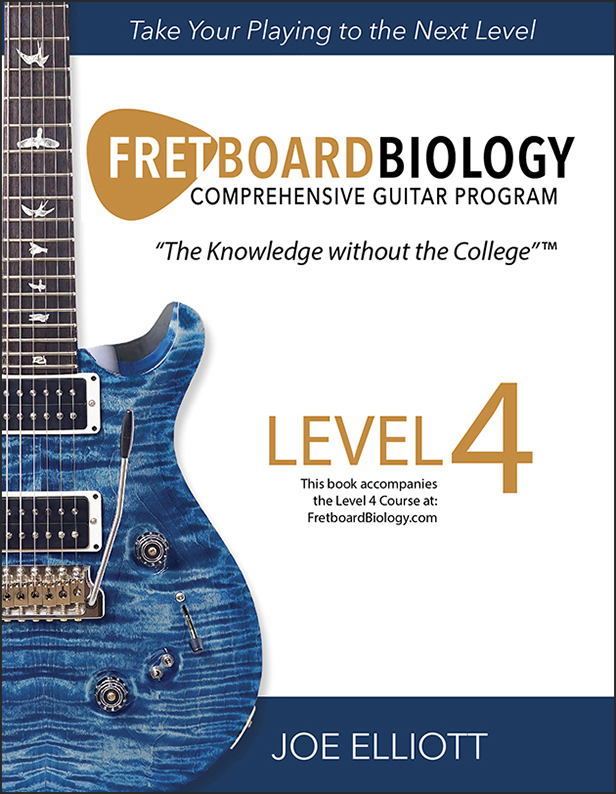
Unit 1
- THEORY: Parallel keys and modal interchange
- FRETBOARD LOGIC: Pattern I superimposed parallel scale shapes, moveable “shell voicings” for major 7th and dominant 7th chords with 5th and 6th string roots, diatonic 3rds of minor scales alone 2-string sets
- RHYTHM GUITAR: Comping in classic R&B
- IMPROVISATION: Soloing over a progression with modal interchange
- PRACTICE: Unit 1 practice routine
Unit 2
- THEORY: Harmonic analysis with modal interchange in progressions using triads
- FRETBOARD LOGIC: Pattern II superimposed parallel scale shapes, moveable “shell voicings” for minor 7th, and minor 7th flat 5 chords with 5th and 6th string roots, diatonic 3rd of major and minor scales along the 2nd and third strings
- RHYTHM GUITAR: Comping in classic R&B
- IMPROVISATION: Soloing over a progression with modal interchange
- PRACTICE: Unit 2 practice routine
Unit 3
- THEORY: Harmonic analysis with modal interchange in progressions using triads
- FRETBOARD LOGIC: Pattern III superimposed parallel scale shapes, Root Maps – playing chords by number using shell voicings, diatonic 4ths of major and minor scales along string sets: 1/2, 2/3, 3/4, 4/5, 5/6
- RHYTHM GUITAR: Comping in classic R&B
- IMPROVISATION: Soloing over a progression with modal interchange
- PRACTICE: Unit 3 practice routine
Unit 4
- THEORY: Harmonic analysis with modal interchange in progressions using 7th chords
- FRETBOARD LOGIC: Pattern IV superimposed parallel scale shapes, Root Maps – playing chords by number using shell voicings, diatonic 4ths of major and minor scales along the 2nd and 3rd strings
- RHYTHM GUITAR: Comping in classic R&B
- IMPROVISATION: Soloing over a progression with modal interchange
- PRACTICE: Unit 4 practice routine
Unit 5
- THEORY: Harmonic analysis with modal interchange in progressions using 7th chords
- FRETBOARD LOGIC: Pattern V superimposed parallel scale shapes, Root Maps – playing chords by number within six frets using shell voicings, diatonic 5ths of major and minor scales along the string sets: 1/2, 2/3, 3/4, 4/5, 5/6
- RHYTHM GUITAR: Comping in classic R&B
- IMPROVISATION: Soloing over a progression with modal interchange
- PRACTICE: Unit 5 practice routine
Unit 6
- THEORY: Chord inversions: triads
- FRETBOARD LOGIC: Read progressions by number and Root Map within six frets using shell voicings, diatonic 5ths of major and minor scales along the 2nd and 3rd strings
- RHYTHM GUITAR: Comping in funk
- IMPROVISATION: Soloing over a progression with modal interchange
- PRACTICE: Unit 6 practice routine
Unit 7
- THEORY: Chord inversions: 7th chords
- FRETBOARD LOGIC: In-position parallel harmonized scales: triads, common slash chords as inversion voicings, diatonic 6ths of major and minor scales along the string sets: 1/3, 2/4, 3/5, 4/6
- RHYTHM GUITAR: Comping in funk
- IMPROVISATION: Soloing over a progression with modal interchange
- PRACTICE: Unit 7 practice routine
Unit 8
- THEORY: Reading slash chords for inversions
- FRETBOARD LOGIC: In-position parallel harmonized scales: triads, diatonic 7ths of major and minor scales along the string sets: 1/3, 2/4, 3/5, 4/6
- RHYTHM GUITAR: Comping in funk
- IMPROVISATION: Soloing over a progression with modal interchange
- PRACTICE: Unit 8 practice routine
Unit 9
- THEORY: Harmonic analysis of chords written as slash chords
- FRETBOARD LOGIC: In-position parallel harmonized scales: 7th chords, reading slash chords for inversions, double-stop tricks
- RHYTHM GUITAR: Comping in funk
- IMPROVISATION: Soloing over a progression with modal interchange
- PRACTICE: Unit 9 practice routine
Unit 10
- THEORY: Summary of Level 4, modal interchange, harmonic analysis of progressions with modal interchange, inversions, slash chords
- FRETBOARD LOGIC: In-position parallel harmonized scales: 7th chords, reading slash chords for inversions, double-stop tricks
- RHYTHM GUITAR: Comping in funk
- IMPROVISATION: Soloing over a progression with modal interchange
- PRACTICE: Unit 10 practice routine
LEVEL 5

Unit 1
- THEORY: The harmonic minor scale
- FRETBOARD LOGIC: The five Octave Shape Patterns of the harmonic minor scale
- RHYTHM GUITAR: Comping in Afro-Latin
- IMPROVISATION: Soloing with the harmonic minor scale
- PRACTICE: Unit 1 practice routine
Unit 2
- THEORY: The harmonized harmonic minor scale with triads – augmented and diminished triads
- FRETBOARD LOGIC: Patterns I, III, and V or the harmonic minor scale, 3-string augmented arpeggios, 3-string augmented triad chords
- RHYTHM GUITAR: Comping in classic Afro-Latin
- IMPROVISATION: Soloing with the harmonic minor scale using the Vma arpeggio
- PRACTICE: Unit 2 practice routine
Unit 3
- THEORY: The harmonized harmonic minor scale with 7th chords, minor major 7 chords, and augmented major 7 chords
- FRETBOARD LOGIC: 3-string diminished triad arpeggios, 3-string diminished triad chords
- RHYTHM GUITAR: Comping in Afro-Latin
- IMPROVISATION: Soloing with the harmonic minor scale using the V7 arpeggio
- PRACTICE: Unit 3 practice routine
Unit 4
- THEORY: V7 chords and their use in a minor context
- FRETBOARD LOGIC: The five minor major 7 arpeggios
- RHYTHM GUITAR: Comping in Afro-Latin
- IMPROVISATION: Soloing with the harmonic minor scale using chord tones
- PRACTICE: Unit 4 practice routine
Unit 5
- THEORY: Diminished 7th chords and their function
- FRETBOARD LOGIC: The five augmented major 7 arpeggios, diminished 7th chord voicings
- RHYTHM GUITAR: Comping in classic Afro-Latin
- IMPROVISATION: Soloing with the harmonic minor scale using the diminished 7th arpeggio
- PRACTICE: Unit 5 practice routine
Unit 6
- THEORY: Minor major 7 chords
- FRETBOARD LOGIC: Diminshed 7th arpeggios, the five minor major 7 chord voicings
- IMPROVISATION: Soloing using minor major 7 arpeggios
- PRACTICE: Unit 6 practice routine
Unit 7
- THEORY: Augmented major 7 chords
- FRETBOARD LOGIC: Harmonized harmonic minor “in-position” arpeggios in Pattern II and IV, five augmented major 7 chord voicings
- IMPROVISATION: Soloing with augmented major 7 arpeggios
- PRACTICE: Unit 7 practice routine
Unit 8
- THEORY: Dominant 7 chords, functioning and non-functioning dominant 7 chords
- FRETBOARD LOGIC: Harmonized harmonic minor “in-position” arpeggios in Pattern I, III and V
- IMPROVISATION: Soloing with the harmonized harmonic minor “in-position” arpeggios
- PRACTICE: Unit 8 practice routine
Unit 9
- THEORY: Secondary dominant 7th chords
- FRETBOARD LOGIC: Patterns I and IV mixolydian b9 13 scale
- IMPROVISATION & SOLOING: Soloing over progressions with secondary dominants
- PRACTICE: Unit 9 practice routine
Unit 10
- THEORY: Secondary dominant 7th chord analysis, Level 5 theory summary
- FRETBOARD LOGIC: Patterns II, III and V mixolydian b9 13 scale
- IMPROVISATION & SOLOING: Soloing over progressions with secondary dominants
- PRACTICE: Unit 10 practice routine
LEVEL 6

Unit 1
- THEORY: The modes
- FRETBOARD LOGIC: Adapting the pentatonic shells as the modes
- IMPROVISATION: Soloing over common Dorian progressions with minor pentatonic scales
- PRACTICE: Unit 1 practice routines
Unit 2
- THEORY: The harmonized modes
- FRETBOARD LOGIC: Comparing the parallel natural, dorian, and harmonic minor scales
- IMPROVISATION: Soloing over common Dorian progressions with minor pentatonic scales
- PRACTICE: Unit 2 practice routine
Unit 3
- THEORY: The Dorian mode, a closer look
- FRETBOARD LOGIC: The five Dorian scale patterns, common Dorian progressions
- IMPROVISATION: Soloing with the Dorian scale over common Dorian progressions
- PRACTICE: Unit 3 practice routine
Unit 4
- THEORY: Composite minor
- FRETBOARD LOGIC: Comparisons of Pattern IV natural, harmonic and Dorian minor scales, Pattern IV “in-position” arpeggios in composite minor, common composite minor progressions
- IMPROVISATION: Soloing over composite minor progressions
- PRACTICE: Unit 4 practice routine
Unit 5
- THEORY: Composite minor, harmonic analysis of progressions from parallel minor scales
- FRETBOARD LOGIC: Comparisons of Pattern II natural, harmonic, and Dorian minor scales, Pattern II “in-position in composite minor, common composite minor progressions
- IMPROVISATION: Soloing over composite minor progressions
- PRACTICE: Unit 5 practice routine
Unit 6
- THEORY: Composite minor, harmonic analysis of progressions from parallel minor scales
- FRETBOARD LOGIC: Patterns I, III, and V “in-posistion” arpeggios in composite minor
- IMPROVISATION: Soloing over composite minor progressions
- PRACTIVE: Unit 6 practice routine
Unit 7
- THEORY: The Mixolydian mode, a closer look
- FRETBOARD LOGIC: The five Mixolydian scale patterns
- IMPROVISATION: Soloing over common Mixolydian progressions
- PRACTICE: Unit 7 practice routine
Unit 8
- THEORY: The Lydian mode, a closer look
- FRETBOARD LOGIC: The five Lydian scale patterns
- IMPROVISATION: Soloing over common Lydian progressions
- PRACTICE: Unit 8 practice routines
Unit 9
- THEORY: The Phrygian mode, a closer look, the Locrian scale
- FRETBOARD LOGIC: The five patterns of the Phrygian scale, the five patterns of the Locrian scale
- IMPROVISATION: Soloing over common Phrygian progressions
- PRACTICE: Unit 9 practice routines
Unit 10
- THEORY: Summary of Level 6 Theory
LEVEL 7
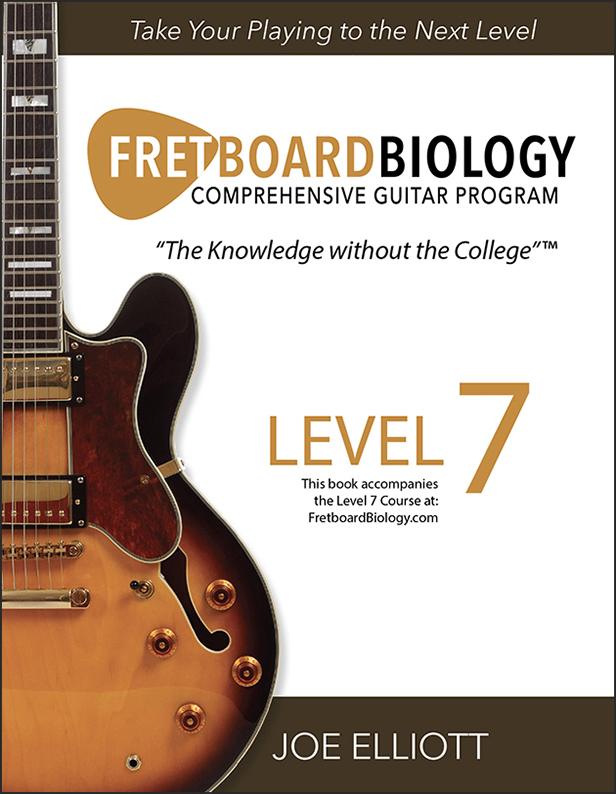
Unit 1
- THEORY: Compound intervals
- FRETBOARD LOGIC: Compound intervals
- IMPROVISATION: Using “in-position” arpeggios
- PRACTICE: Unit 1 practice routines
Unit 2
- THEORY: Extended chords – 9th chords
- FRETBOARD LOGIC: Common 9th chord voicingsT
- IMPROVISATION: Using “in-position” arpeggios
- PRACTICE: Unit 2 practice routine
Unit 3
- THEORY: Extended chords – 11th chords
- FRETBOARD LOGIC: Common 11th chord voicings
- IMPROVISATION: “in-position” connecting game
- PROGRAM: Unit 3 practice routine
Unit 4
- THEORY: Extended chords – 13th chords
- FRETBOARD LOGIC: Common 13th chord voicings
- IMPROVISATION: Using “in-position” arpeggios
- PROGRAM: Unit 4 practice routine
Unit 5
- THEORY: Other chord types
- FRETBOARD LOGIC: Voice leading
- IMPROVISATION: “In-position” connecting game
- PRACTICE: Unit 5 practice routine
Unit 6
- THEORY: Slash chords
- FRETBOARD LOGIC: Voice leading
- IMPROVISATION: “In-position” connecting game
- PRACTICE: Unit 6 practice routine
Unit 7
- THEORY: Chord families
- FRETBOARD LOGIC: Voice leading
- IMPROVISATION: “In-position” connecting game
- PRACTICE: Unit 7 practice routine
Unit 8
- THEORY: Diatonic substitution
- FRETBOARD LOGIC: Voice leading
- IMPROVISATION: “In-position” connecting game
- PRACTICE: Unit 8 practice routines
Unit 9
- THEORY: Modulation
- FRETBOARD LOGIC: Voice leading
- IMPROVISATION: “In-position” connecting game
- PRACTICE: Unit 9 practice routines
Unit 10
- THEORY: A guide to common chord symbols
- FRETBOARD LOGIC: Voice leading
- IMPROVISATION: “In-position” connecting game
- PROGRAM: Unit 10 practice routine
LEVEL 8
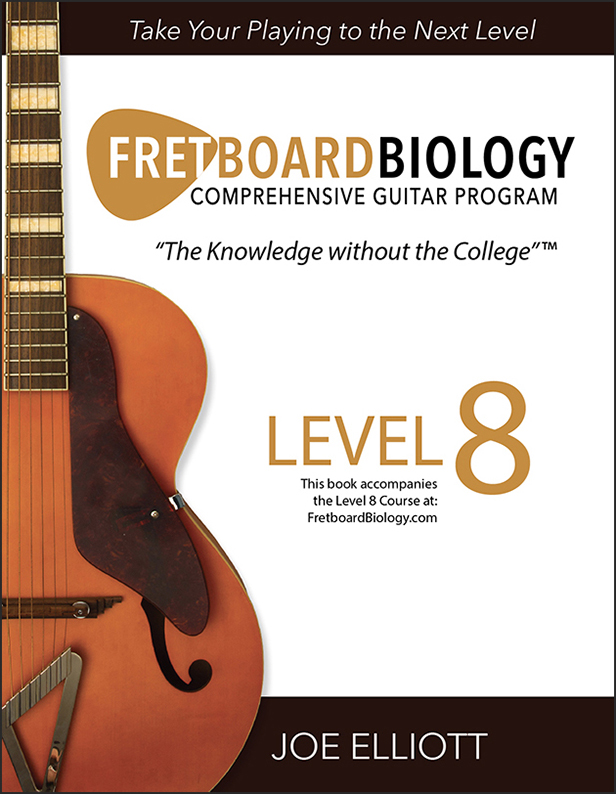
Unit 1
- INTRODUCTION: Understanding chord tones in soloing, in-position arpeggios, 13 common jazz progressions, vocabulary development, vocabulary as finger paths, harmonic analysis in jazz—perceived modulations
Unit 2
- FRETBOARD LOGIC: Review in-position arpeggios
- COMPING: Constructing walking bass lines while comping when chords change every 2 beats
- IMPROVISATION: “Connecting” arpeggios in major II-V-I progressions 1 and 2
Unit 3
- COMPING: Constructing walking bass lines while comping when chords change every 2 beats
- IMPROVISATION: “Connecting” arpeggios in major II-V-I progressions 3 and 4
Unit 4
- THEORY: Avoid tones
- COMPING: Constructing walking bass lines while comping when chords change every 4 beats
- IMPROVISATION: Lick writing, lick-writing worksheet
Unit 5
- THEORY: Functioning and non-functioning dominants, altered scale
- COMPING: Constructing walking bass lines while comping when chords change every 4 beats
Unit 6
- THEORY: The melodic minor scale
- COMPING: Shell voicings
Unit 7
- THEORY: The melodic minor scale correlation with altered scale
- COMPING: Shell voicings
Unit 8
- COMPING: Guide tones
- IMPROVISATION: Lick writing common progressions 1-4, lick-writing worksheets with altered scales
Unit 9
- COMPING: Guide tones
- IMPROVISATION: Lick writing common progressions 1-4, lick-writing worksheets with diatonic substitution
Unit 10
- COMPING: Rhythm placement
- IMPROVISATION: Utilizing vocabulary for common progressions 1-4
Unit 11
- THEORY: The harmonized melodic minor scale, harmonized melodic minor scale and altered application
- COMPING: Rhythm placement
- IMPROVISATION: Lick-writing worksheets with melodic minor arpeggios
Unit 12
- THEORY: The Locrian #2 scale, harmonized melodic minor scale and Locrian #2 application
- COMPING: Extensions and alterations
- IMPROVISATION: Developing and utilizing vocabulary using Locrian #2 in common progressions 3 and 4
Unit 13
- COMPING: Extension and alterations
- IMPROVISATION: Lick writing common progressions 5 and 6 and lick-writing worksheets with altered scales
Unit 14
- COMPING: Comping with arpeggios of melodic minor
- IMPROVISATION: Utilizing vocabulary for common progressions 5 and 6
Unit 15
- COMPING: Comping with arpeggios of melodic minor
- IMPROVISATION: Lick writing common progressions 7 and 8 and lick-writing worksheets with altered, Locrian #2, and melodic minor arpeggios
Unit 16
- COMPING: Comping for common situations
- IMPROVISATION: Utilizing vocabulary for common progressions 7 and 8
Unit 17
- THEORY: Non-functioning dominants, Lydian b7 scale
- COMPING: Comping for common situations
Unit 18
- COMPING: Comping for common situations
- IMPROVISATION: Utilizing vocabulary using the Lydian b7 scale
Unit 19
- COMPING: Comping for common situations
- IMPROVISATION: Utilizing vocabulary for common progressions 9 and 10
Unit 20
- THEORY: Non-functioning dominants
- COMPING: Comping for common situations
Unit 21
- COMPING: Comping for common situations
- IMPROVISATION: Utilizing vocabulary for common progression 11
Unit 22
- COMPING: Comping for common situations
- IMPROVISATION: Utilizing vocabulary for common progressions 12 and 13
Unit 23
- COMPING: Comping for common situations
- IMPROVISATION: Using dominant diminished and whole tone scales
Unit 24
- THEORY: Other common harmonic situations
- COMPING: Comping for common situations
Unit 25
- THEORY: Advanced harmonic analysis
- COMPING: Comping for common situations
- IMPROVISATION: Utilizing all concepts learned in a jazz standard context
Frequently Asked Questions
FRETBOARD BIOLOGY is a very unique program, and we receive a lot of questions about it. Below are some of the most common questions we receive. If your question is not addressed here, please CONTACT US HERE. We are happy to help.
Unlike most of the guitar education available on the internet, FRETBOARD BIOLOGY is not designed to teach you how to play your favorite songs, bits and pieces of theory, or a few licks. It is a full academic music program designed to provide you with a professional-level education on guitar. You will learn how to think like a musician, how to understand what is happening musically within a song, and how to play with intention for specific emotional effect. In short, you will learn how to become a competent musician, how to communicate with other musicians like a professional, and how to play great guitar parts in any musical genre.
The FRETBOARD BIOLOGY program is not well-suited for a brand new guitar player. The nature of the content is more suitable for an intermediate to advanced guitar players. To get the most from this program, you should:
- Be able to play at least some major, minor, or pentatonic scales cleanly and in good time.
- Be able to play both major and minor barre chords and the G, C, D, E, A, Dmi, Emi, and Ami open chords.
- Be able to play complete songs, either on your own or along with a recording.
- Be able to play some kind of solo—even if a simple one—over a basic chord progression.
Many students in the FRETBOARD BIOLOGYprogram are advanced, but since you can work at your own pace, you don’t have to already be a great guitar player to be successful in this program. Having some basic abilities will greatly improve the pace of your success.
There are several areas of competence that you will achieve by going through the FRETBOARD BIOLOGY program:
- Theory: You will gain an understanding of the structure of music and how different musical elements interact to create a great experience for the listener. This allows you to be intentional in your writing and performing to create the kind of sound and emotion that you want, rather than guessing.
- Fretboard Logic: You will master the fretboard of the guitar and will feel comfortable playing any scale, arpeggio, or chord in any voicing and in any position on the neck. This flexibility will open up a lot of choices for crafting your unique style of playing.
- Rhythm Guitar: You will learn the classic guitar vocabulary that define all the contemporary musical genres: Blues, Classic Rock, Folk, Funk, Reggae, Country, Jazz, Fusion, and R&B.
- Technique: You will learn various articulation techniques such as hammer-ons, pull-offs, bends, release bends, slides, vibrato, and harmonics, as well as numerous drills for developing right- and left-hand dexterity.
- Improvisation: You will learn how to play more powerful and intentional solos that emotionally touch the audience by learning about motif development, the five elements of contrast, storytelling techniques, and, later in the program, advanced soloing concepts.
- Practice Routines: Your practice routine is critical to your success. In every Unit throughout the entire course, you will develop a highly organized and effective practice routine to help you develop your knowledge and skills as efficiently as possible.
No. There is no audition necessary for the FRETBOARD BIOLOGY program. However, for the best experience, you should at least have basic playing skills. These were discussed in the “Is This the Right Program for Me” section above.
Yes. We do require people to start at the beginning, but read through the paragraph below.
Here’s the deal: This program has a specific and unique content organization that starts from the very beginning. Even if you already know much of the material in the lower levels, understanding this organizational system will help you work through the higher levels. If you already have a lot of musical knowledge and skills, you can move through the initial content quickly, while making sure that you don’t miss any important ideas that will impede your progress later on in the program. If you are a teacher, starting at the beginning will help you understand how to present foundational information.
Each Unit in the program is intended to take approximately one week to complete. While it may be tempting to move through the content quicker, your best path to success is to spend enough time on each individual Unit until you have completely mastered the information. There are a total of 92 Units in the program, so it will take between 18-24 months to complete if you work on it consistently.
No. Just like any other academic program, there is a specific sequence of information to help you develop the knowledge and skills for your success. Simply taking the classes you want to take will leave large gaps in your competence as a musician. There are many websites that will allow you to be completely self-directed in what you learn. Unfortunately, approaching your guitar education in that way will inhibit your development as a player. This program has been battle-tested with thousands of students, many of whom have gone on to very successful careers in music.
The FRETBOARD BIOLOGY program is offered at a monthly subscription for $29 per month or an annual subscription for $299 per year.
Yes. We offer a free 7-day evaluation period for you to see whether this program is right for you. We are confident that once you see the quality of the program and the value you receive for your subscription, you will decide to continue the program.
While the FRETBOARD BIOLOGY program does not require a lot of expensive equipment, there are some pieces of equipment that will be necessary in order to complete this program. Here is a short list:
- Electric Guitar: While the theory in the program is applicable to all guitar types, the improvisation, rhythm, and technique sections will be difficult to perform on an acoustic guitar. It is best to have an electric guitar.
- Computer or Tablet: You will need something to view the videos and read and/or download the text. While this is possible on a phone, the small screen size will make it more difficult to see what is happening in the demonstrations.
- Metronome: Developing good timing is critical for skill development on the guitar. Practicing to a metronome is the most effective way to develop good timing.
- A Way to Hear Yourself Play: This can be a practice amplifier or some other playback system that allows you to hear yourself. Whatever system you decide to use, it will be important to be able to create a clean tone as well as add some effects to your playing.
- A Way to Record Yourself: Listening is a critical skill for the guitarist. Being able to record yourself and listen back to what you played will help you develop a better sense of how your playing actually sounds.
- A Way to Print Materials: There are several worksheets and text that can be downloaded and printed.
FRETBOARD BIOLOGY offers optional private instruction referrals to seasoned professional instructors selected by Joe Elliott. Each instructor has many years of experience teaching the FRETBOARD BIOLOGY curriculum at the college level in both the classroom and in private lessons.
The information you provide helps us match you with the best instructor for your background and interests. All of our instructors are indpendent instructors and are not employees of FRETBOARD BIOLOGY. For this reason, setting up your lesson dates and times and payment arrangements will be made directly with the instructor. The cost for private lessons is $30 for a 30 minute lesson and $50 for a 60 minute lesson. You can change instructors at anytime should you decide to simply by contacting us.
Joe and other FRETBOARD BIOLOGY instructors monitor the forums in the Student Community and do their best to answer questions posted by students. You may also receive feedback from more advanced players in the FRETBOARD BIOLOGY program. There is also the opportunity to get peer and instructor feedback when you post recorded examples of your solos or songs in the Student Community area in the Student Center.
Yes. FRETBOARD BIOLOGY has a Student Community that allows students to ask questions, exchange peer feedback, and post examples of their playing. The Student Community are also monitored by the instructors, so they may offer feedback and suggestions as well.
The FRETBOARD BIOLOGY program can be adapted for private instruction. If you are an instructor who would like to use the FRETBOARD BIOLOGY content when teaching your students, we just ask that your student purchase the books and/or subscription so that we can continue to produce great content.

